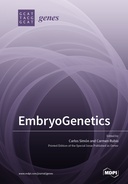Explore

EmbryoGenetics
0 Ungluers have
Faved this Work
Login to Fave
The science of human genetics has advanced at an exponential pace since the double-helix structure of DNA was identified in 1953. Within only 25 years of that discovery, the first gene was sequenced. Subsequent efforts in the span of a few decades have brought advanced next-generation sequencing and new tools for genome editing, allowing scientists to write and rewrite the code of life. We are now realizing that genetics represents yet another system of information technology that follows Moore’s law, stating that computer processing power roughly doubles every two years. Importantly, with such rapid and sophisticated advancements, any tools or studies applicable to adult genetics can now also be applied to embryos.Genetic disorders affect 1% of live births and are responsible for 20% of pediatric hospitalizations and 20% of infant mortality. Many disorders are caused by recessive or X-linked genetic mutations carried by 85% of humans. Because assisted reproduction has armed us with technologies like in vitro fertilization that provide access to human embryos, we began to screen some genetic diseases simply by selecting sex. The first live births following preimplantation genetic testing (PGT) to identify sex in X-linked disease were reported by Alan Handyside in 1990. This groundbreaking work used the identification of male embryos and selective transfer of unaffected normal or carrier females as proof-of-concept to avoid genetic diseases, paving the way to extend the concept to PGT for monogenic diseases (PGT-M), including Mendelian single-gene defects (autosomal dominant/recessive, X-linked dominant/recessive), severe childhood lethality or early-onset disease, cancer predisposition, and HLA typing for histocompatible cord-blood stem cells’ transplantation. Later, we moved onto the identification and selection of euploid embryos by analysing all 23 pairs of chromosomes in 4–8 cells from the trophectoderm, called PGT for aneuploidy (PGT-A). PGT-A currently leverages next-generation sequencing technologies to uncover meiotic- and mitotic-origin aneuploidies affecting whole chromosomes, as well as duplications/deletions of small chromosome regions. A step forward was the use of structural chromosome rearrangements (PGT-SR) to identify Robertsonian and reciprocal translocations, inversions, and balanced vs. unbalanced rearrangements. Another advancement came with PGT for polygenic risk scoring (PGT-P). This technique takes us from learning how to read simple words to starting to understand poetry (i.e., evolving from PGT-M/A/SR to PGT-P for multifactorial, polygenic risk prediction). Moreover, we are moving from embryo selection to intervention because the genetic code is not only readable, but also re-writeable. Indeed, gene editing is now possible using tools like CRISPR/Cas9, which are applicable to all species, including human embryos.
This book is included in DOAB.
Why read this book? Have your say.
You must be logged in to comment.
Rights Information
Are you the author or publisher of this work? If so, you can claim it as yours by registering as an Unglue.it rights holder.Downloads
This work has been downloaded 123 times via unglue.it ebook links.
- 123 - pdf (CC BY) at Unglue.it.
Keywords
- advanced maternal age
- aneuploidies
- aneuploidy
- Apoptotic bodies
- Autosomal dominant polycystic kidney disease (ADPKD)
- blastocyst
- chromosomal abnormality
- combined preimplantation genetic testing
- DNA
- embryo
- embryo genetics
- Embryos
- endometrium
- Exosomes
- extracellular vesicles
- female age
- genetic diseases
- Genetic Testing
- Genome editing
- genomic index
- implantation
- Infertility
- Male Infertility
- microvesicles
- monogenic disease
- mosaicism
- multiplex PCR
- murine blastocysts
- next-generation sequencing
- NGS
- ovarian response
- Perinatal Care
- PGT-A
- PGT-P
- PGT-SR
- polygenic disease
- polygenic risk scoring
- preimplantation embryos
- preimplantation genetic testing
- Preimplantation genetic testing for aneuploidy assessment (PGT-A)
- Preimplantation genetic testing for monogenic disorders (PGT-M)
- Reference, information & interdisciplinary subjects
- relative risk reduction
- Reproductive health
- Research & information: general
- segmental
- SNP array
- thema EDItEUR::G Reference, Information and Interdisciplinary subjects::GP Research and information: general
- translocations
- uterus
- vitrification
- whole exome sequencing
- window of implantation
Links
DOI: 10.3390/books978-3-0365-1153-5Editions

